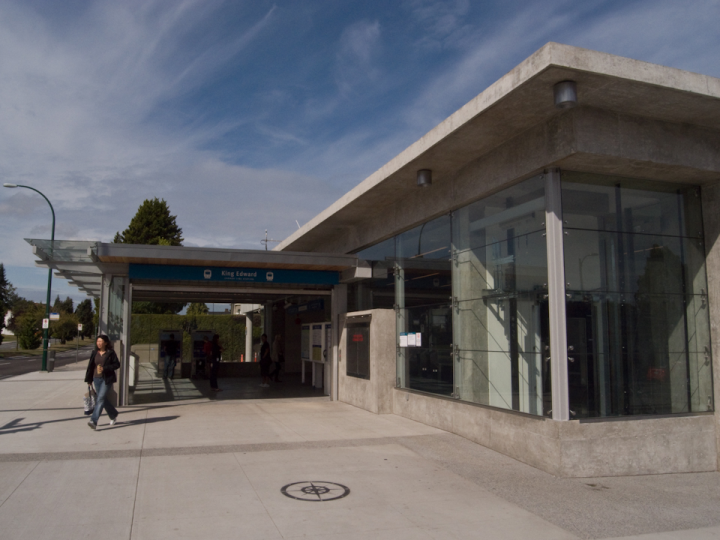
Being an illustrated mini-travelogue on taking the new Canada Line train to Vancouver airport. Almost certainly of interest only to people who might do such a thing.
We live near 19th and Ontario; the nearest station is thus King Edward. I asked Lauren to drive me over there, which cost her under ten minutes there and back, and saved me a twenty-minute walk; but I’ll walk next time the load is light and the day is bright.
The stations are not exactly glamorous; I wonder how drab they’ll look on one of our many grey winter days.
My camera says I got there at 11:16 AM.
· · ·
· · ·
So in the middle of a Friday, the trains are running pretty often.
The tunnel is very narrow and the train doesn’t seem to go that fast, but then there are only six stops to the airport. In the tunnel it’s kind of gloomy even with the nice cheery interiors of the cars. Then you emerge to go over the Fraser river. Here’s another train coming over toward us as we head out of Marine Drive station.
Riding the trains is something I’m accustomed to doing in foreign cities, not at home; it was novel to me to hear the announcements in a mid-range Canadian, the only English that to my ear is completely uninflected.
The snarl of tracks south of the Fraser where the Richmond and airport trains sort themselves out is really complex; I suppose it needs to be. Oddly, the rails are already rusty-brown, albeit with bright metal on top where the trains run.
Here we are approaching the airport, somewhere past the ridiculously lonely and deserted Templeton station.
Once you get out in the sun the cars are much cheerier inside. Once again, I wonder what it’ll be like on a steely-grey day or rainy December night.
If you’re wanting to go International/US and you’re in a hurry, you want the back end of the train; and the front for domestic flights. The station at the airport is nicer, with a bit of architectural effort.
Here we are in International Departures. The camera says 11:45, so that’s 29 minutes elapsed. Which includes buying tickets, waiting for the train to arrive, stopping to take a couple of pictures in the airport station, and the really rather long walk through the station, across the road, and over to International. If you’re on Air Canada you have further still to go, they’re way down at the far end.
It’s all very painless. If you have a lot of luggage the savings compared to a taxi might not be worth it. I think that in low-traffic times of day, we could get there quicker by car, but not a whole lot.
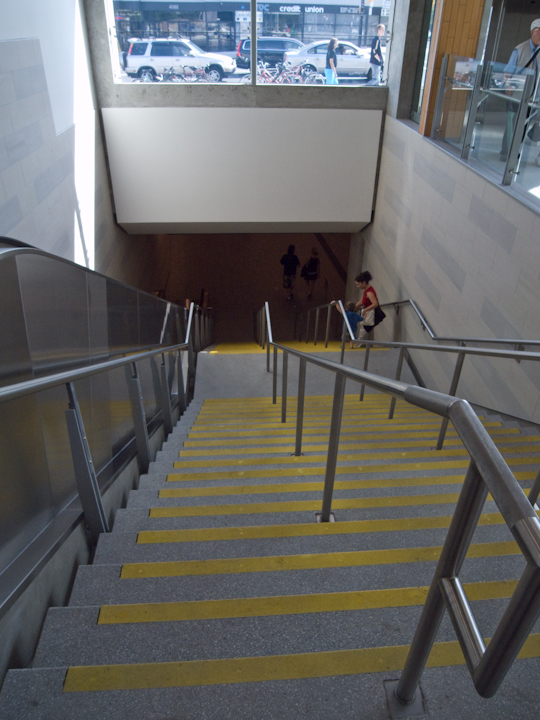
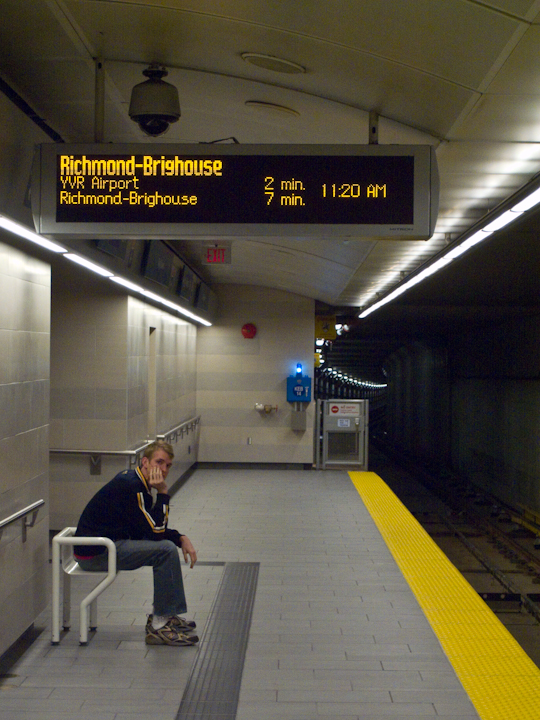
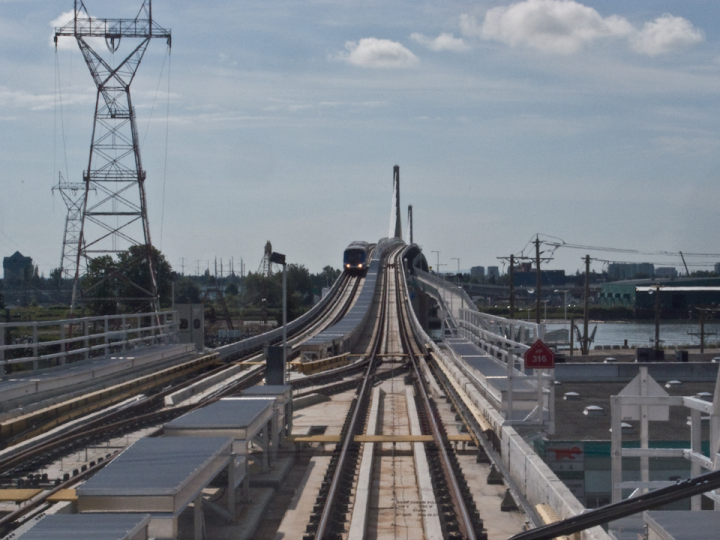
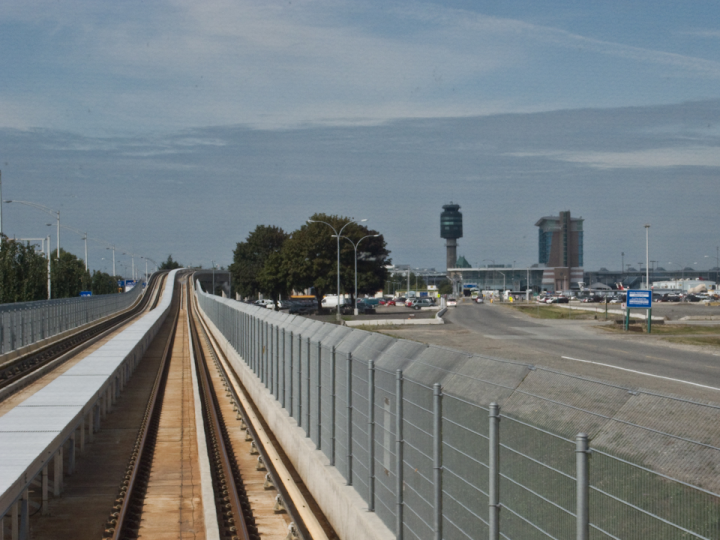
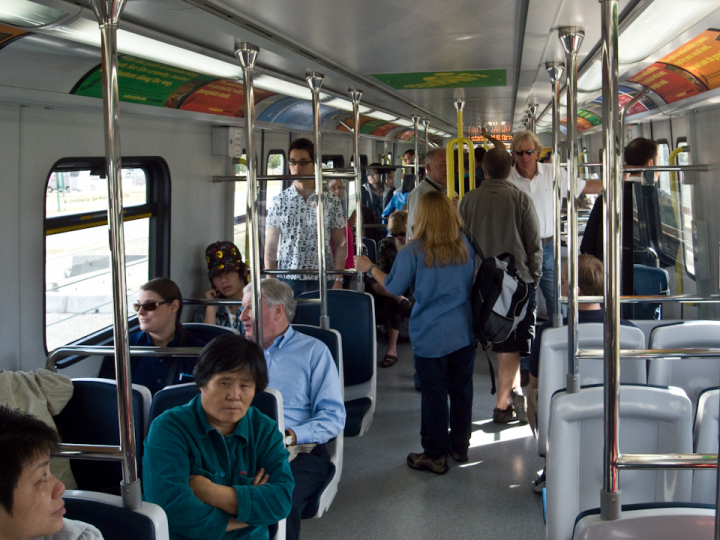
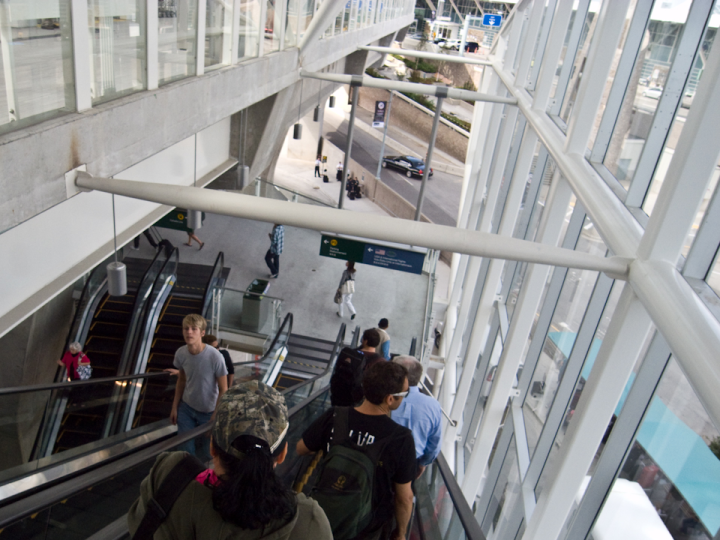
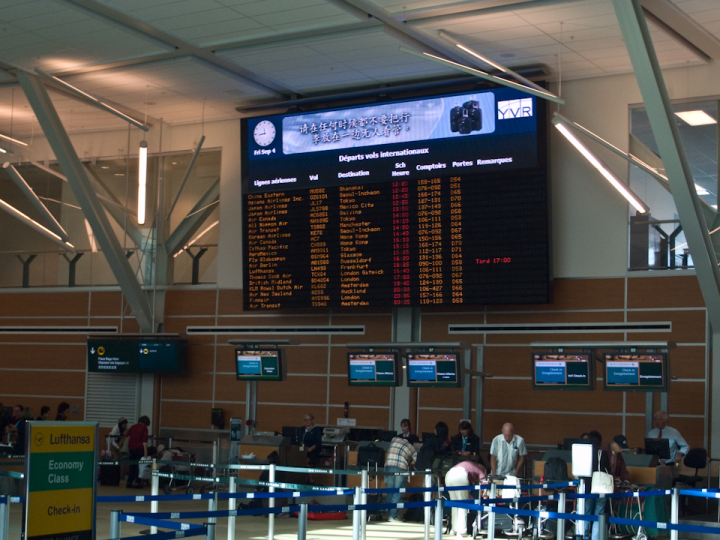

Comment feed for ongoing:
From: Paul Hoffman (Sep 05 2009, at 08:15)
It's probably too late to ask, but I hope you give the same treatment for the trip from Narita to Tokyo. Those trains are pretty nice too!
[link]
From: John Cowan (Sep 05 2009, at 08:44)
The reason the rails are rusty-brown, of course, is that they're just plain steel: not painted, not galvanized, not alloyed with anything, and so in any but the driest climates, they rust almost as soon as they come from the mill. In the maintenance-of-way business, we remove shiny bright worn-out rails and replace them with spanking new rails totally covered with rust.
That's where trains run fairly often, of course; in track with less than one train a day, the rust can easily keep up with the wear. The New York City subwayis at the opposite extreme, where one train every 20 minutes is considered minimal middle-of-the-night service. Our curved track needs to be replaced about every 18 months because of the wear and tear on it, though straight track lasts for years.
Why so much wear? Basically because train axles are solid and don't have differentials. Consequently, when going around a curve, the wheels on the outside can't roll properly. They have to skid instead, giving us the much-hated shrieking noises produced by hot steel-on-steel action. That friction causes the rails to slowly be destroyed, and when they are battered enough, it's out with the old rails and in with the new.
Rail is always delivered to the site in a straight condition, and then bent to shape on the spot and (in NYC) welded in place. Welding sections of rail together eliminates the clickety-clack-clickety-clack noises of wheels going over rail joints, plus providing reliable electrical continuity for the grounded side of the third-rail power, which is 600 volts DC in these parts and has to deliver some unspeakably high amperage.
Something you don't mention is the substantial energy efficiency of heavy-rail service where (and this is key) there's enough traffic to justify it. Emissions are also lowered greatly overall, and are concentrated at the power plant rather than distributed throughout the city. Of course, that's not counting the energy and emissions needed to *build* the thing. (The NYC subways run on the same power as the rest of the city, just transformed and rectified.)
Yours railfannishly,
[link]
From: Claire (Sep 05 2009, at 11:37)
It's great to see SkyTrain finally going to the airport! My partner and I have lots (hundreds) of photos of the construction process of the Millennium line, especially the area right around Willingdon and the Lougheed Highway in Burnaby, so SkyTrain is close to our hearts.
[link]
From: Janne (Sep 05 2009, at 19:07)
@John Cowan: why aren't differentials used on trains? Are curved sections rare enough that you lose more money in the differential (energy loss) than in replacing rail sections and wheels?
Or perhaps they are used at times? I just realized that I hardly ever hear that squeaky noise in the Osaka subway, just in one particularly tight bend on one line I use.
[link]
From: Damien Diederen (Sep 06 2009, at 02:50)
@Janne: You might want to watch this short video in which Richard Feynman explains how trains actually work:
http://www.youtube.com/watch?v=y7h4OtFDnYE
Enlightening!
[link]
From: BWJones (Sep 06 2009, at 08:01)
Yes, please... an equivalent post from Narita to Tokyo is exactly what I am looking for.
[link]
From: orcmid (Sep 06 2009, at 20:39)
As far as I can tell, the rails come in rusty brown and they stay that way. The newly-inaugurated light rail service here in Seattle shows the same characteristics.
YOu can see it here: http://www.flickr.com/photos/orcmid/3798913446/in/set-72157601313495795/
and in the rails here (check low foreground too): http://www.flickr.com/photos/orcmid/3844297054/sizes/l/in/set-72157601313495795/
[link]
From: Jacek (Sep 07 2009, at 07:29)
As far as I understand it, the rust really protects the metal underneath it.
[link]
From: Paul Prescod (Sep 10 2009, at 18:59)
Is "take the train to Tokyo" something you're just supposed to know?
When I visited with our mutual friend Mg37 and a couple of other friends/co-workers, none of us knew what a terrible idea it is to take a taxi from the airport.
[link]